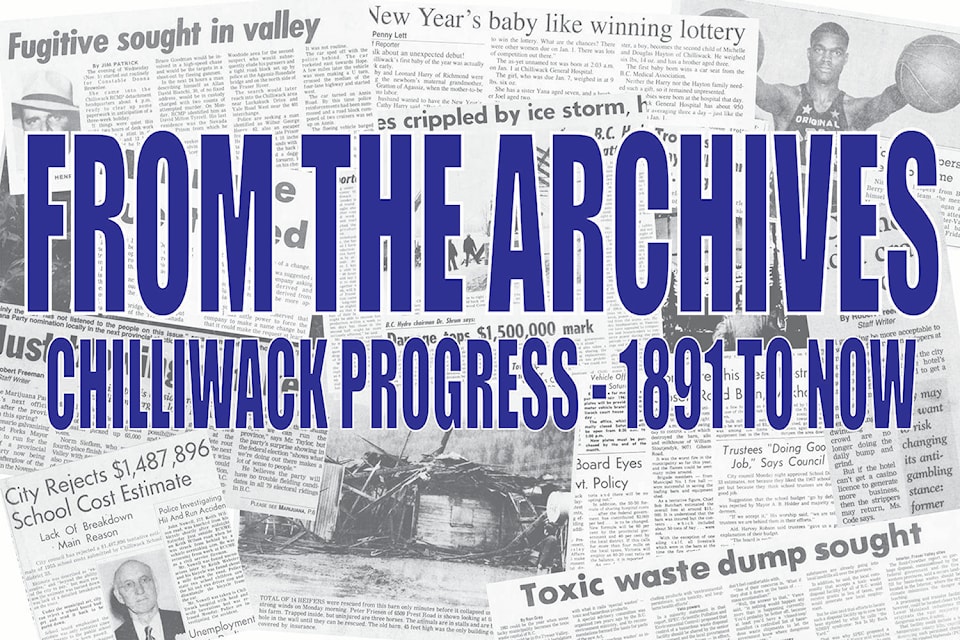Since first publishing on April 16, 1891 the Chilliwack Progress has been the newspaper of record in Chilliwack.
One hundred and 28 years later the Progress remains the longest continuously published newspaper in British Columbia. With the addition of a thriving digital operation anchored by theprogress.com, the Progress delivers more news to more people than ever before.
‘From the Progress Archives’ is a journey into the past, to see what was making news decades ago.
—————————————————————————-
Headline: Work prison study funded
Date: January 21, 1981
Reporter: Ron Gray
Darryl Plecas has a new plan for Canadian prisons.
If it works, he says, it will significantly reduce prison costs, and provide a powerful motivation for released prisoners to stay out of trouble.
If it does not work, we will still get the benefit of about a 70 per cent reduction in prison costs.
The plan looks so promising that a new institute has been created with a $160,000 foundation grant to study this and three other proposals.
Plecas, a sessional instructor and program assistant at Fraser Valley College, is also the research assistant on the college team conducting a study for Corrections Canada on the community impact of prisons in Kent and Harrison Hot Springs.
His new prison plan is outlined in a 17-page paper entitled ‘Getting a Rebate on the Half-Million Dollar Man.’
The ‘half-million dollar man’ in the title refers to the cost of each new lifer who must spend at least 25 years in prison at a cost of $25,000 a year in 1977 dollars.
Today’s cost would be closer to $36,000 a year, which would bring the cost of a life sentence for a first-degree murder to about $900,000.
Plecas’ proposal calls for the creation of two classes of prisons in Canada: ‘work’ and ‘non-work’ prisons.
Work prisons would engage in the production of goods which Canada now imports because labour costs make them too expensive to manufacture domestically.
Examples that would not compete with B.C. industries include:
- heating equipment;
- switch gear and protective equipment, such as circuit breakers;
- costume jewelry and silverware;
- optical apparatus such as binoculars; and
- electrical generators and motors
Living conditions in work prisons would be significantly better than at non-work prisons.
The harsher non-work prisons would be for inmates who refused to agree to work assignments or who could not be assigned to work prisons for security reasons.
Plecas also calls for the creation of a ‘Canadian Corrections Corporation’ to handle management and marketing of inmate-produced goods on a profit-oriented basis.
Only time spent in a work institution would count towards remissions of sentences. Inmates would be entitled to one day of remission for every day in a work prison.
Any behavioural problems would result in a prisoner being sent back to a non-work prison.
These provisions alone would provide a saving to Canadian taxpayers of $26 million a year by allowing disbanding of the National Parole Board and the Parole Service.
The parole board’s difficult role as ‘guesstimator’ of inmates’ worthiness for early release would be replaced by a computer tallying time spent in work prison, says Plecas.
The supervisory function of the parole officer would be replaced by private agencies such as the John Howard Society, but would be largely unneeded, he adds, because of the plan’s powerful incentive for a released inmate to stay out of trouble.
That incentive is money.
While working, the inmate would be paid minimum wage, currently $3 an hour.
That would would not be paid at the time earned, however.
It would be paid to the inmate after release, and at the rate at which it had been earned.
Since $3 an hour equals about $6,000 a year, an inmate would be assured of a $500 a month income as long as he remained ‘clean,’ for a time equal to the time he had served in work prisons.
Thus, a prisoner sentenced to 20 years could be out in 10 if his prison behaviour were exemplary.
Once out, he would have a $60,000 incentive to go straight: he would be paid $500 a month for 10 years if he remained crime free.
Any involvement in crime during that 10 years would result in the loss of both the balance of his remission time, and the balance of his earnings fund, as well as a new sentence for the new crime.
“It is important to stress that the wages the offender earns are conditional, and that he must agree to their conditional nature,” adds Plecas.
The release funds would stabilize the offender’s income when he hits the street, making a transition to a straight lifestyle easier.
The compound interest on the inmates’ earnings held in a reserve fund constitute the ‘rebate’ of the title of Plecas’ report.
For the 20 year lifer who costs taxpayers half a million dollars under present penal operations, the ‘rebate’ would amount to about $350,000 — approximately 70 per cent reduction in the per-inmate cost of incarceration.
The grant from the Donner Foundation is being used to create the Institute for Studies in Criminal Justice Policy, now headquartered at Simon Fraser University, but slated to move into offices in downtown Vancouver next week.
That institute is assigning Plecas to organize a research and planning group for a detailed feasibility study into the scheme.
Plecas, who lives in Abbotsford, expects to have that team ready to start work by August. It will comprise mostly criminology, sociology and research specialists from UBC and SFU.
